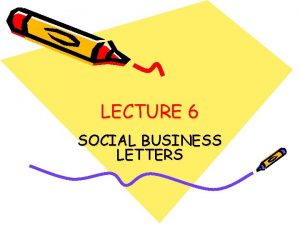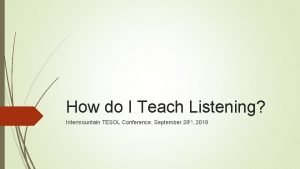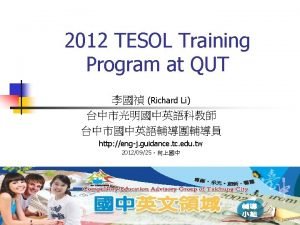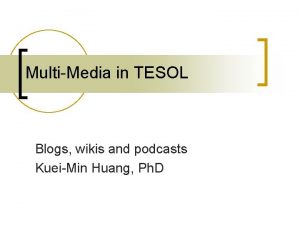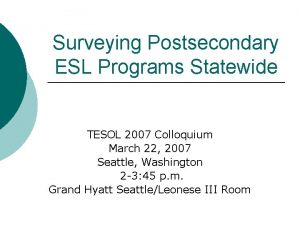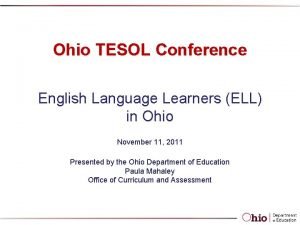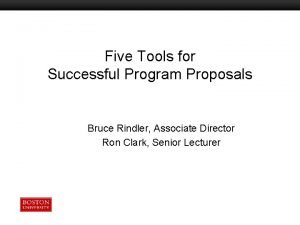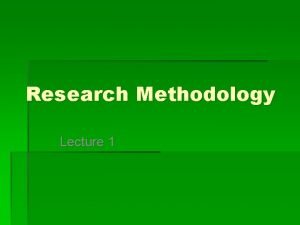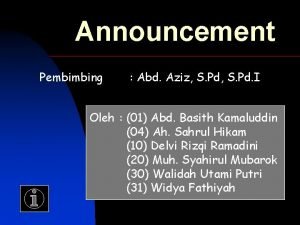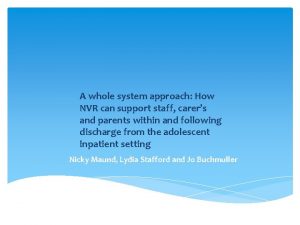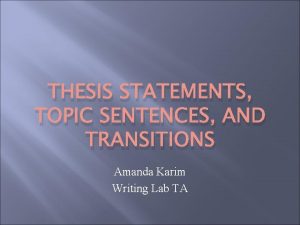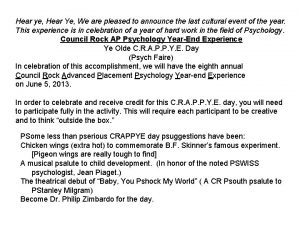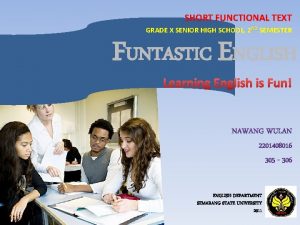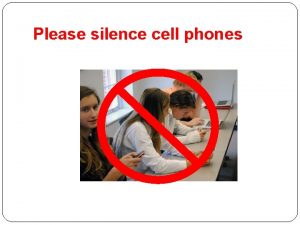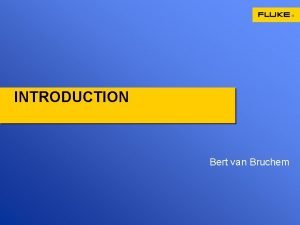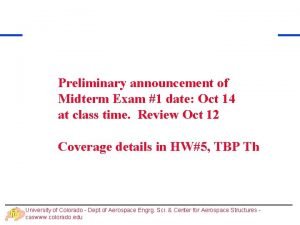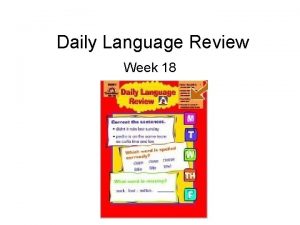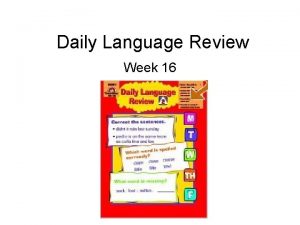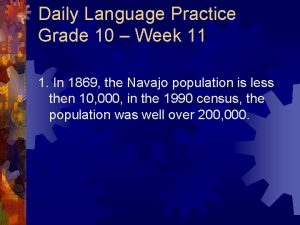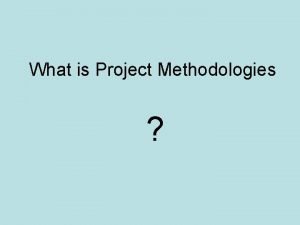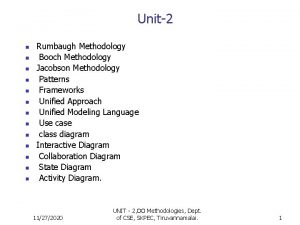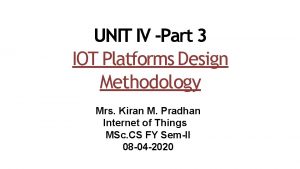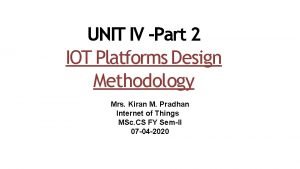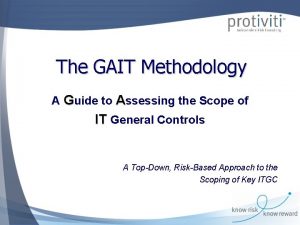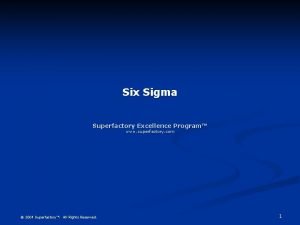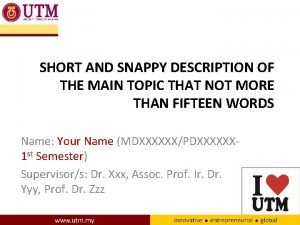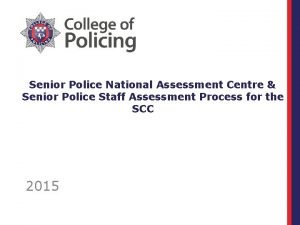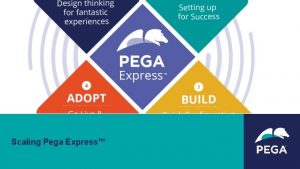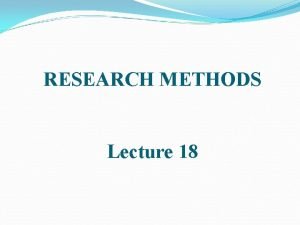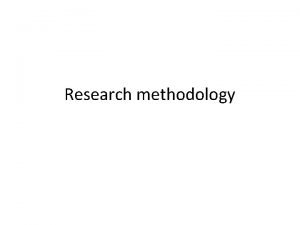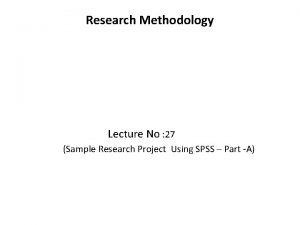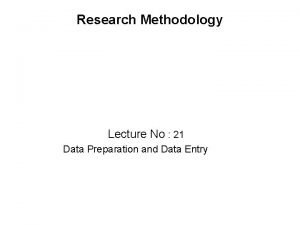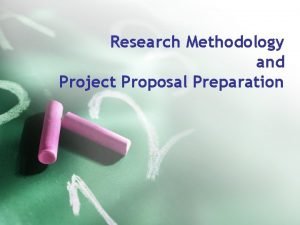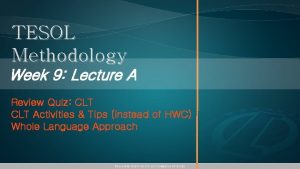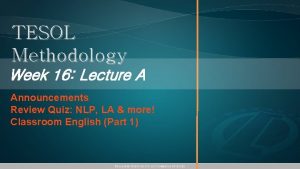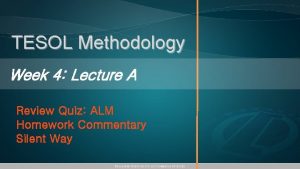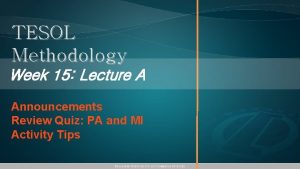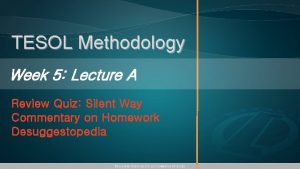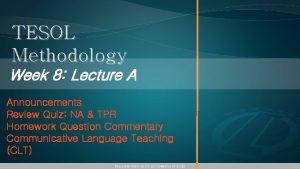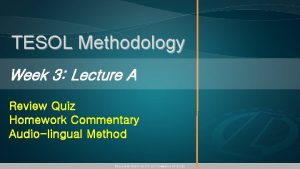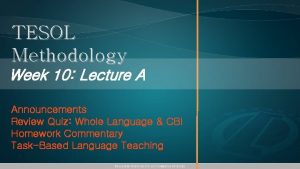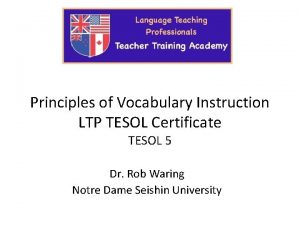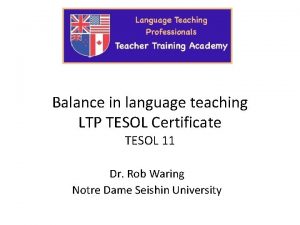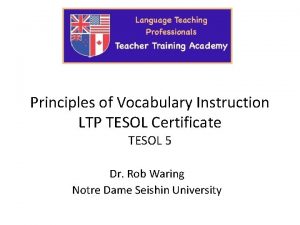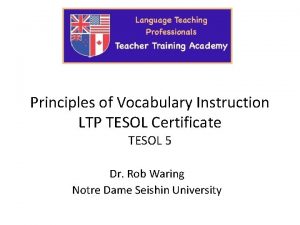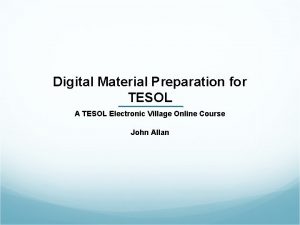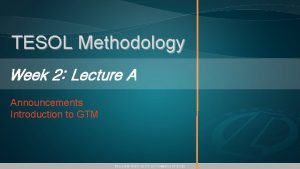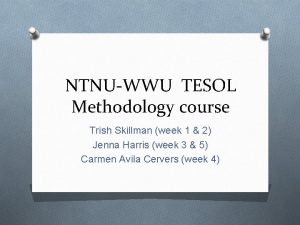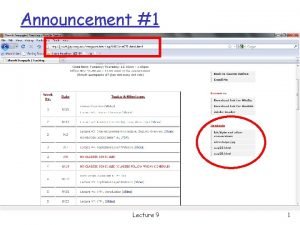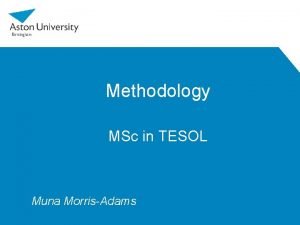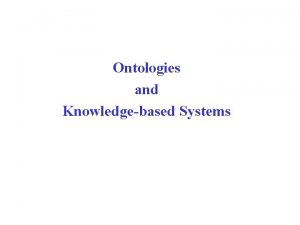TESOL Methodology Week 12 Lecture A Announcement Review









































































- Slides: 73

TESOL Methodology Week 12: Lecture A Announcement Review Quiz: TBLT Cooperative Language Learning

1 Announcement Project 1 & Project 2 Good job on your poster presentations. It was nice to have a chance to meet you in person. Project 2: I will introduce it in Lecture B

1 Review Quiz 2 Question One Which of the following aspects does TBLT share with CLT? (a) focus on meaning (b) communicative activities (c) lots of classroom interaction (d) purposeful & meaningful tasks

1 Review Quiz 2 Question Two TBLT differs from CLT in its focus on the task as the primary source of ______ in the classroom. (a) assessment (b) interaction (c) input (d) instruction

1 Review Quiz 2 Question Three In the TBLT approach, which is not considered an appropriate condition for language learning? (a) motivation (b) comprehensible input (c) active language use (d) focus on form

1 Review Quiz 2 Question Four Which of the following is a key component of language acquisition in TBLT, but not in the Natural Approach? (a) communicative use of language (b) silent period (c) comprehensible input (d) output opportunities

1 Review Quiz 2 Question Five Which of the following is not a typical TBLT task? (a) listening to a lecture & taking a test (b) making a phone call to book tickets (c) reading a dilemma & offering advice (d) looking at a map & giving directions

TESOL Methodology Cooperative Language Learning Intro & Background Principles & Characteristics

1 Intro & Background Basic Concepts • Cooperative LL is part of a general instructional approach called Collaborative Learning • Makes maximum use of cooperative activities in pairs & small groups • LL dependent on socially structured exchange of info between Ss • Ss are accountable for their own learning and motivated to increase the learning of others

1 Intro & Background Aims of Collaborative Learning • Raise the achievement of all Ss, including those who are gifted or academically challenged • Help T build positive relationships among Ss • Give Ss the XPs they need for healthy social, psychological and cognitive development • Replace competitive environment with a team-based, cooperative one

1 Intro & Background Goals of Cooperative LL • Provide opportunities for naturalistic TL acquisition through interactive pair & group activities • Enable focused attention to particular lexical items, linguistic structures and communicative functions through interactive tasks

1 Intro & Background Goals of Cooperative LL • Provide opportunities for learners to collaboratively develop successful learning & communication strategies • Enhance learner motivation, reduce learner stress, create a positive affective classroom climate

1 Intro & Background Video Introduction You are about to watch an introduction to the basic concepts & benefits of Cooperative Learning as reflected in strategies called Kagan Structures. This video was made by Kagan Publishing & Professional Development, a company that produces publications and workshops based on the research and work of Dr. Spencer Kagan.

1 Intro & Background Before the Video Things to look for • What looks different about these classrooms? • How does this style of education differ from traditional methods? • What feedback does the teacher give about it? How about the students? • What benefits are claimed about these techniques?

1 Intro & Background After the Video: Summary Something very different is happening, something special. Ss are not seated in rows. They are not asked to be quiet, to keep their eyes on their own work…just the opposite! Ss are working together, interacting with each other, exploring the curriculum like never before. Notice how actively engaged Ss are in the learning process.

1 Intro & Background Video Summary Notice how they enjoy working together, watch as they celebrate each other’s successes. Quite a difference from independent work, or worse yet, competitive structures, where Ss hope for their classmates to fail. We put Ss on the same side, rather than keeping them isolated or pitting them against each other.

1 Intro & Background Video Summary Benefits Claimed • Accelerated academic achievement • Development of thinking skills • Enhanced social skills & social relations • Increased liking for school, class and academic content • More participation & engagement in learning

1 Principles & Characteristics 2 Major Objectives of Cooperative LL • Foster cooperation, not competition • Develop critical thinking skills • Develop communicative competence through socially structured interaction

1 Principles & Characteristics 2 View of Language An interactive & cooperative view of language & LL based on 5 premises: 1. Humans are “born to talk. ” All normal children growing up in a normal environment learn to talk. We are biologically “programmed” to talk.

1 Principles & Characteristics 2 View of Language 2. Talk is conversation. Most talk and speech is organized as conversation. Communication is the primary purpose of language, and most people spend a large part of their lives engaged in conversational activities.

1 Principles & Characteristics 2 View of Language 3. Conversation operates according to maxims – we communicate following unconsciously agreed upon “rules. ” ü ü Maxim of Quality – be truthful Maxim of Quantity – not too much/little Maxim of Relation – be relevant Maxim of Manner – be brief & orderly, and avoid obscurity & ambiguity

1 Principles & Characteristics 2 View of Language 4. Maxims in L 1 We learn how cooperative maxims are realized in our native language through casual, everyday conversation. 5. Maxims in L 2 We learn them through participation in cooperatively structured interactional activities, just like those in Coop LL.

1 Principles & Characteristics 2 Advantages of Cooperative LL • Increased frequency & variety of TL practice through different types of interaction • Possibility for development or use of lg. in ways that support cognitive development & increased lg. skills • Opportunities to integrate learning with CBI and TBL

1 Principles & Characteristics 2 Advantages of Cooperative LL • Opportunities to include greater variety of curricular materials to stimulate LL & concept learning • Opportunities for Ss to act as resources for each other, assuming more active roles in their learning

1 Principles & Characteristics 2 Role of the Teacher As facilitators, Cooperative LL teachers must always be ready to: • Interact • Instruct • Refocus • Question • Clarify • Expand • Celebrate • Empathize

1 Principles & Characteristics 2 Role of the Teachers provide supportive behavior: • Give feedback • Redirect the group with questions • Encourage problem resolution • Extend activities • Stimulate thinking • Manage conflict • Observe individuals & group dynamics • Supply resources

1 Principles & Characteristics 2 Role of the Teacher Characteristics of cooperative teachers: • Speak less than in T-centered classes • Give few commands & directives • Impose minimal disciplinary control • Provide broad questions to challenge learners & stimulate thinking • Prepare Ss for tasks they will carry out • Assist Ss with learning activities • Be flexible & ready to adapt

1 Principles & Characteristics 2 Role of the Teacher Restructuring old content: • Reshape existing lessons, curriculum and resources cooperatively • Tailor cooperative lessons to unique instructional needs, circumstances, curricula, subject areas and Ss • Diagnose problems Ss may have in working together • Intervene when necessary to increase effectiveness of groups

1 Principles & Characteristics 2 Learners & Learning In Cooperative LL there are four major concepts connected to learners and the learning process: • • Learning is a constructive process Learning depends on rich contexts Learners are diverse Learning is inherently social

1 Principles & Characteristics 2 Learners & Learning LL is an active, constructive process • To learn new info, ideas or skills, Ss have to work actively with them in purposeful ways • Ss need to integrate new material with what they already know • Ss are not just taking in new info or ideas, they are creating something new and constructing meaning

1 Principles & Characteristics 2 Learners & Learning depends on rich contexts • LL is fundamentally influenced by context and activity • Cooperative activities immerse Ss in challenging tasks & questions • Ss are immediate practitioners, not distant observers • Rich contexts challenge Ss to practice & develop higher order reasoning & problem solving skills

1 Principles & Characteristics 2 Learners & Learning Learners are diverse • Ss have multiple perspectives, learning styles, backgrounds, needs, experiences, and aspirations • Ts cannot assume “one size fits all” • When Ss work together, Ts get a direct & immediate sense of how they learn and what XPs they bring • Ss benefit, complement, and learn from each other

1 Principles & Characteristics 2 Learners & Learning is inherently social • Cooperative learning produces intellectual synergy of many minds coming to bear on a problem • Learning stimulates socially mutual engagement in a common endeavor • Collaborative exploration, meaningmaking and feedback leads to better understanding and new discoveries


TESOL Methodology Week 12: Lecture B Sample Lesson Analysis Techniques & Materials Video: Pair & Group Work

1 Lesson Analysis Sample Lesson from TPLT To give you an idea of what Cooperative LL looks like in an actual classroom, we will analyze the sample lesson from TPLT through our exploaratory questions. To refresh your memory about the particular details of this lesson, please read through the section entitled “Experience” on pages 186 -189 now.

1 Lesson Analysis 1. Goals of Teacher Foster cooperation rather than competition. SLT: The main activity of the lesson is done in groups, with all Ss helping each other instead of being “pitted against each other” as in traditional competitive school environments. On the quiz, each S benefits from the good performance of the others, rather than being threatened by it.

1 Lesson Analysis 1. Goals of Teacher Help the Ss develop communicative competence through socially structured interaction activities. SLT: The story activity is structured around inter and intra-group interaction, with an overt emphasis on social skills.

1 Lesson Analysis 2. Role of Teacher & Students In cooperative learning groups, leadership is ‘distributed, ’ with individual Ss often given particular roles to fulfill as the group completes tasks together. (This is also done in TBL) SLT: T suggests the roles of taskmaster, recorder, timekeeper, checker, and reporter for different Ss of each group.

1 Lesson Analysis 3. Teaching / Learning Process Language acquisition facilitated by Ss interacting in TL together. SLT: During the story activity the Ss are busy working in their groups and across groups, with much lively talking and interaction.

1 Lesson Analysis 3. Teaching / Learning Process Learning is an interdependent process of shared accountability, with Ss dependent on and responsible for each other. SLT: When checking the vocab quiz, Ss compare & combine scores together amongst themselves, then put their group score on each of their papers…

1 Lesson Analysis 3. Teaching / Learning Process SLT: Collective performance on the story vocabulary task has consequences above the individual: o Group score 90 -100% - nobody has to take the quiz again o Group score <89% - everybody retakes the quiz o Room score >90 - extra recess time

1 Lesson Analysis 3. Teaching / Learning Process Although the focus is on group interaction, each S is also held individually accountable for their work and their learning. SLT: Ss take the vocabulary quiz individually, with their scores having both group & individual consequences – your grade is still your grade.

1 Lesson Analysis 4. Teacher-Student Interaction Ss encouraged to think in terms of ‘positive interdependence’ – thinking cooperatively, in terms of the group, not competitively & individualistically. SLT: The story worksheet is done in cooperative groups, with each S helping the other Ss learn the new words.

1 Lesson Analysis 4. Teacher-Student Interaction Ss are members of different groups for different activities. Some of these are long-term groups, which help Ss form lasting relationships and learn how to work together over extended periods. SLT: Before they begin the activity, one S asks which groups they should form, to which T replies accordingly.

1 Lesson Analysis 5. Feelings of Students Cooperation fosters positive feelings & connections among Ss, which increases motivation. Ss are responsible for each other academically & socially. SLT: Throughout the lesson there is an affirmative, optimistic atmosphere, with all of the Ss helping each other, learning from each other, and encouraging each other to do better.

1 Lesson Analysis 6. View of Language & Culture Groups are usually mixed according to gender, ability level and ethnic group, so Ss learn from and get along with people who are different from them. SLT: (in picture) In international classes like this, integration allows Ss to share their culture, exposing them to new points of view while letting them see their similarities as human beings.

1 Lesson Analysis 7. Language Areas / Skills In addition to lg. skills, social skills are taught explicitly: acknowledging the contributions of others, encouraging others to participate, keeping conversation calm, etc. SLT: Ss worked on the social skill of encouraging others: both aurally (Nice job! Way to go!), nonverbally (smile, nod, clapping, cheering) and physically (pat on the back).

1 Lesson Analysis 9. Evaluation T should be willing to hand over some responsibility to the Ss, even the traditional T’s job of “grading. ” This means trusting the Ss. SLT: The Ss check and score their own work, and report their results to the T, who accepts these results without double-checking individual papers.

1 Techniques 2 3 Group Types 1. Formal Cooperative Learning Groups • Short term, lasting from one class period to several weeks • Established for a specific task • Ss work together to achieve shared learning goals

1 Techniques 2 3 Group Types 2. Informal Cooperative Learning Groups • Ad-hoc groups lasting from a few minutes to a full class period • Used to focus Ss’ attention or facilitate learning • For all kinds of games, activities and academic work

1 Techniques 2 3 Group Types 3. Cooperative Base Groups • Long-term, lasting for a semester or full year • Stable group membership with strong internal relationships • Members give each other support, help, encouragement, both academically and personally

1 Techniques 2 Group Formation Activities When forming long-term groups at the beginning of the semester, give them time to discuss together & decide: • Group Name • Group Motto • Group Song Presentation: Each group introduces themselves, explains how their name & motto reflect who they are, and performs their song together.

1 Techniques 2 Group Roles (TPLT 189) Ss can choose roles to fulfill group during activities, for example: • Taskmaster: keeps group focused on task overall • Recorder: writes down & organizes all information • Timekeeper: keeps track of time • Checker: checks to see that each step has been done • Reporter: presents results to the class

1 Techniques 2 Cooperative LL Activities Some examples of “Kagan Structures” • • • Three-step Interview Roundtable / Round Robin Think-Pair-Share Numbered Heads Partners

1 Techniques 2 Cooperative LL Activities Three-step Interview 1. Ss are in pairs – one is interviewer, the other interviewee 2. Conduct Q&A, reverse roles 3. Each shares with the group what was learned

1 Techniques 2 Cooperative LL Activities Roundtable (a piece of paper & pen for each group) 1. One S makes a contribution (idea, feeling, opinion) by writing it down 2. Passes paper & pen to the left 3. Each S makes a contribution in turn The oral version is called Round Robin.

1 Techniques 2 Cooperative LL Activities Think-Pair-Share 1. T poses a question (low-consensus) 2. Everybody thinks silently 3. Ss discuss their responses in pairs 4. Ss share their partner’s response with the class

1 Techniques 2 Cooperative LL Activities Numbered Heads 1. Groups “number off” 2. T asks a question (high consensus) 3. Heads Together – Ss literally put heads together, make sure they all know & can explain answer 4. T calls a number and Ss with that number shares what his/her group thinks

1 Techniques 2 Cooperative LL Activities Partners 1. Each group divided in half, partners go to separate sides of room 2. Each side is given content to master and teach to the other half 3. Partners work together to learn the material and can consult with other partners from different groups 4. Teams are reunited, each set of partners teaches & quizzes the other

1 Video: Pair & Group Work 3 Video Introduction In this video you will some techniques of Cooperative LL applied to two classroom situations. This video is part of the program called Shaping the Way We Teach English developed by the University of Oregon. Ignore reference to modules and the “Describe, Interpret, Evaluate” process, and focus on the pair & group work.

1 Video: Pair & Group Work 3 Before the Video Things to look for • Why do Ts use pair & group work? • What kinds of activities are used? • How are the groups organized? • What kinds of interactions do you see? • What roles do Ts and Ss fulfill? • How are groups motivated to do well? • What is the class atmosphere?

1 Video: Pair & Group Work 3 After the Video: Summary Class 1 (T/F Game): • Motivation: winners get extra points • Ss couldn’t help each other during the game, so cooperation is vital to the initial group interaction phase • Students worked cooperatively, actively used English to complete the task, and had fun!

1 Video: Pair & Group Work 3 After the Video: Summary Class 2 (paragraph writing): • Ss collaborated to form sentences in groups, exploring grammar together • Later: class feedback session • Sometimes T led the class, sometimes “stepped back” to let Ss manage themselves in groups • T checked in with groups to offer guidance and redirection as needed

1 Video: Pair & Group Work 3 Video Summary Reasons for pair & group work: • Accommodate individual differences & learning styles of students • Provide opportunities for different types of cognitive involvement • Allow for unexpected learning • Motivate learners with variety of engaging & interesting activities

1 Homework Questions 4 Question 1 In Task-Based Learning, what is a task? (Definition). And how is a task similar to and different from a commutative activity? (Provide example to show me you understand the difference. )

1 Homework Questions 4 Question 2 Have you every experienced taskbased learning in your own language learning experiences? If so, describe the task cycle? If not, what kind of task would you like to try with your own Ss.

1 Homework Questions 4 Question 3 How are Cooperative Language Learning and Task-Based Language Learning similar? How are they different?

1 Project #2: Introduction 5 Lesson Plan & Micro-Teaching • Look at the Lesson Plan and Micro. Teaching handout on my website • Choose a language topic from the list of suggestions or pick another topic of your own choosing (hint: pick something easy) • Set you teaching context (Age & Level of your Ss and your Ss learning objective • Write out your procedures and identify the method and the rational for each step

5 Project #2: Introduction 1 Lesson Plan & Micro-Teaching Procedures Method / Rationale -play classical background music -Desugg / to relax Ss -put picture on PPT and ask Ss in groups to brainstorm words and phrases -CLT / treat Ss as knowledgeable participants and check prior knowledge

1 Project #2: Introduction 5 Lesson Plan & Micro-Teaching • Plan a 20 minute speaking lesson using best practices (that means, creatively use the various methods we have learned this semester to teach effectively) • After teaching you will receive feedback • Use feedback to write a reflection on your micro-teaching experience

1 Project #2: Introduction 5 Lesson Plan & Micro-Teaching • Send me a rough draft of your lesson plan by email so I can give you feedback before you teach

 Tesol methodology
Tesol methodology Social business letter
Social business letter Tesol course university of queensland
Tesol course university of queensland Intermountain tesol
Intermountain tesol Tesol course qut
Tesol course qut Tesol wiki
Tesol wiki Ucsb extension tesol
Ucsb extension tesol Ohio tesol
Ohio tesol Boston university
Boston university Pprr cycle
Pprr cycle Research methods notes kenya
Research methods notes kenya Research methodology lecture
Research methodology lecture 01:640:244 lecture notes - lecture 15: plat, idah, farad
01:640:244 lecture notes - lecture 15: plat, idah, farad Week by week plans for documenting children's development
Week by week plans for documenting children's development Dan hughes shield of shame
Dan hughes shield of shame Presidential elections exploration and announcement
Presidential elections exploration and announcement Announcement there will be a holiday camp next month
Announcement there will be a holiday camp next month Mmai illinois
Mmai illinois Circular letter example
Circular letter example What is the subject of the announcement
What is the subject of the announcement Our school will hold a study tour to prambanan temple
Our school will hold a study tour to prambanan temple Nvr announcement example
Nvr announcement example Willard scott birthday announcement form
Willard scott birthday announcement form Thesis statement transitions
Thesis statement transitions Public service announcement deforestation
Public service announcement deforestation Pvu background
Pvu background Hear ye definition
Hear ye definition Short functional text announcement
Short functional text announcement Please silence your cell phone announcement
Please silence your cell phone announcement Bert van bruchem
Bert van bruchem Midterm exam announcement
Midterm exam announcement Define ideological parties
Define ideological parties Please turn off your cell phone announcement
Please turn off your cell phone announcement 5 a day language review week 6
5 a day language review week 6 Daily language review week 18 answers
Daily language review week 18 answers Did you see big
Did you see big Week 14 dgp
Week 14 dgp Daily language practice
Daily language practice My friend jose will travel here on tuesday
My friend jose will travel here on tuesday Chapter review motion part a vocabulary review answer key
Chapter review motion part a vocabulary review answer key Writ of certiorari ap gov example
Writ of certiorari ap gov example Nader amin-salehi
Nader amin-salehi Systematic review definition
Systematic review definition Narrative review vs systematic review
Narrative review vs systematic review Methodology for final year project
Methodology for final year project It chargeback methodology
It chargeback methodology Use case collaboration
Use case collaboration Iot design methodology examples
Iot design methodology examples The fourth step in the iot design methodology is
The fourth step in the iot design methodology is Domain model specification in iot design methodology is
Domain model specification in iot design methodology is Qualitative and quantitative research
Qualitative and quantitative research Research problem example
Research problem example Itgc controls
Itgc controls Theoretical paradigm example
Theoretical paradigm example Stradis methodology
Stradis methodology Parallel development
Parallel development Objectives of research methodology
Objectives of research methodology What is sa/sd methodology?
What is sa/sd methodology? Dfss methodology
Dfss methodology Research methodology flow chart
Research methodology flow chart Police national assessment centre
Police national assessment centre Pega express
Pega express Steps of research proposal
Steps of research proposal Slidetodoc
Slidetodoc Adam rhodri
Adam rhodri Criteria for good measurement in research methodology
Criteria for good measurement in research methodology What is dimension in research
What is dimension in research Methodology in resume
Methodology in resume Methodology vs research design
Methodology vs research design Steps in research process
Steps in research process Proposed methodology example
Proposed methodology example Field editing in research methodology
Field editing in research methodology Types of methodology in project proposal
Types of methodology in project proposal What is methodology
What is methodology

